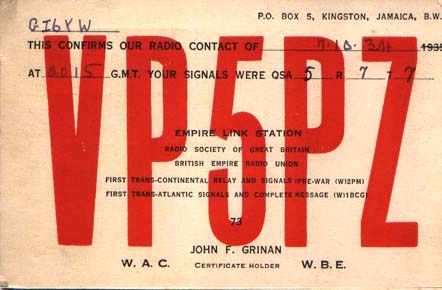

VP5PZ 1934 Jamaica
John F. Grinan (1894-1957): earliest call letters -- "JG", then active from Jamaica as nj2PZ and VP5PZ. He also operated from the stations 2PM and 1BCG in the United States.
John Francis Grinan, son of Juan "John" Grinan and Mercedes Sutiezez Sutiezez, was born November 28, 1894 in Kingston, Jamaica and died May 22, 1957 in St. Petersburg, Florida. His parents moved the family to New York in 1902. John Grinan returned to Jamaica in the early 1930s where he became a successful planter. He returned to the United States in 1940 and became a naturalized citizen in 1947.
Prior to 1929 no U.S. call sign was assigned to him, but in the early 1920s he operated from the station of Adolph J. Faraon, 2PM, and used Faraon's call sign. W5KNE
John Grinan, First Amateur to Communicate Across Continent and Atlantic…
One of the most romantic figures in the army of radio amateurs is John F. Grinan, known intimately to all amateurs as "Johnny." From the days when the coherer was the sole detector in radio work, and a ten-inch spark coil the only transmitter, John Grinan has been hard at work in the field of wireless communication, and so qualifies as one of the oldest members of the fraternity of radio amateurs. He is a director of the exclusive Radio Club of America--the "Four Hundred" of radio circles--and has been chosen as the subject of this week's interview.
Mr. Grinan has the enviable distinction of being the first amateur to send a message across the continent with amateur equipment, and last December added to his laurels by sending the first amateur message across the Atlantic Ocean.
He originally achieved outstanding recognition from his fellow amateurs by instituting the first relay across the continent from New York to Los Angeles and return in March, 1917. On that occasion a message was relayed from one amateur station to another, and the reply received within one hour and forty-five minutes from the time Grinan started the message on its long passage across the continent and back.
The First Trans-Continental Message
He followed this up with excellent work until a few weeks later he actually succeeded in sending a message from New York to Los Angeles direct without relay, using only 450 watts power in his synchronous spark transmitter at Station 2-PM. This is less than one-half of an electric horsepower.
Then last year came the famous first trans-Atlantic communication with the station erected at Ardrossan, Scotland, by Paul F. Godley. Grinan with his associates--Major Edwin H. Armstrong, inventor of the regenerative circuit; E. V. Amy, the short wave antenna expert; George E. Burghard, president of the Radio Club of America, Minton Cronkhite and Walker Inman--erected a special amateur station at Greenwich, Conn., which has become famous under its call letters of 1-BCG.
Night after night during these tests the associates kept watch at the station, and sent out their messages in the hope Godley would pick them up. Fate strangely enough chose Grinan for the successful role, and it was his message that was the first to be received from this country by Godley. During these tests Grinan also succeeded in communicating direct with the Island of Santa Catalina off the coast of California, a distance greater than that of Scotland. ...
Info adapted from 'Radiophone "Valve" needed to Prevent Interference,' New-York Tribune (New York, NY), April 9, 1922, p. 6. (Library of Congress, Washington, DC. http://chroniclingamerica.loc.gov/lccn/sn83030214/1922-04-09/ed-1/seq-26/
QSL G4UZN Collection
Info courtesy of W5KNE